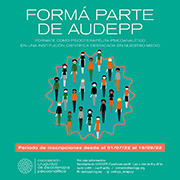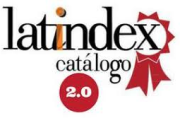CUANDO SOMOS MÁS DE DOS
DOI:
https://doi.org/10.53693/ERPPA/2.1.6Keywords:
psychotherapy, psychotropic drug, integrationAbstract
In this paper, we describe the main characteristics, positive aspects and difficulties of the treatment that constitute psychotherapy and psychopharmacology. Reference is made to the perspective of patients and technicians. Emphasis is placed on communicational variables, the transference-countertransference pair, and the frame.
Finally, we suggest guidelines to optimize this way of working.
Downloads
References
AZARETTO, C. y ROS, C. B. (2015). Las relaciones del psicoanálisis y otros campos de saber en términos de multidisciplina-interdisciplina-transdisciplina. Memorias del VII Congreso Internacional de Investigación y Práctica Profesional en Psicología. XXII Jornadas de Investigación, XI Encuentro de Investigadores en Psicología del MERCOSUR. Facultad de Psicología, Universidad de Buenos Aires.
BLEGER, J. (1967). Psicoanálisis del encuadre psicoanalítico. Revista de Psicoanálisis, 24(2), 241-258.
CUIJPERS, P., VAN STRATEN, A., WARMERDAM, L. y ANDERSSON, G. (2009). Psychotherapy versus the combination of psychotherapy and
pharmacotherapy in the treatment of depression: a meta‐analysis. Depression and anxiety, 26(3), 279-288. https://onlinelibrary.wiley.
com/doi/epdf/10.1002/da.20519
DE JONGHE, F., HENDRICKSEN, M., VAN AALST, G., KOOL, S., PEEN, V., VAN, R., VAN DEN EIJNDEN, E. y DEKKER, J. (2004). Psychotherapy alone and combined with pharmacotherapy in the treatment of depression. The British Journal of Psychiatry, 185(1), 37-45.
DONATTI, S., GARAY, C. J. y ETCHEVERS, M. J. (2015). La comunicación entre psicólogos clínicos y psiquiatras en el tratamiento combinado (psicoterapia y farmacoterapia) en salud mental. Anuario de investigaciones, 22, 29-38.
DRIESSEN, E., DEKKER, J. J., PEEN, J., VAN, H. L., MAINA, G., ROSSO, G., RIGARDETTO, S., CUNIBERTI, F., VITRIOL, V. G., FLORENZANO, R. U.,
ANDREOLI, A., BURNAND, Y., LÓPEZ-RODRÍGUEZ, J., VILLAMIL-SALCEDO, V., TWISK, J. W. R. y CUIJPERS, P. (2020). The efficacy of adding short-term psychodynamic psychotherapy to antidepressants in the treatment of depression: A systematic review and meta-analysis of individual participant data. Clinical Psychology Review, 80(101886). https://doi.org/10.1016/j.cpr.2020.101886
ELLISON, J. M. (2005). Teaching collaboration between pharmacotherapist and psychotherapist. Academic Psychiatry, 29(2), 195-202.
FERNÁNDEZ-ÁLVAREZ, H., KIRSCH, H., LAGOMARSINO, A. y PAGÉS, S. (2000). Psicoterapia y psicofármacos ¿Cómo y cuándo combinarlos? Vertex, Revista Argentina de Psiquiatría, 11(39), 5-12.
GABBARD, G. O. y KAY, J. (2001). The fate of integrated treatment: whatever happened to the biopsychosocial psychiatrist? American Journal of Psychiatry, 158(12), 1956-1963.
JINDAL, R. D., y THASE, M. E. (2003). Integration of care: integrating psychotherapy and pharmacotherapy to improve outcomes among
patients with mood disorders. Psychiatric Services, 54(11), 1484-1490.
KAMENOV, K., TWOMEY, C., CABELLO, M., PRINA, A. M. y AYUSO-MATEOS, J. L. (2017). The efficacy of psychotherapy, pharmacotherapy and their combination on functioning and quality of life in depression: a meta-analysis. Psychological Medicine, 47(3), 414-425.
KANDEL, E. R. (1998). A new intellectual framework for psychiatry. American Journal of Psychiatry, 155(4), 457-469.
KOENIGSBERG, H. W. (1994). The combination of psychotherapy and pharmacotherapy in the treatment of borderline patients. The Journal of Psychotherapy Practice and Research, 3(2), 93-107.
LEE, T. S. W. y HILLS, O. F. (2005). Psychodynamic perspectives of collaborative treatment. Journal of Psychiatric Practice, 11(2), 97-101.
LEICHSENRING, F., ABBASS, A., HILSENROTH, M. J., LEWEKE, F., LUYTEN, P., KEEFE, J. R., MIDGLEY, N., RABUNG, S., SALZER, S. y STEINERT, C. (2017). Biases in research: risk factors for non-replicability in psychotherapy and pharmacotherapy research. Psychological Medicine, 47(6), 1000-1011.
LINDEN, D. E. J. (2006). How psychotherapy changes the brain–the contribution of functional neuroimaging. Molecular Psychiatry, 11(6), 528-538.
LIPOVETZKY, G. y AGREST, M. (2006). Aspectos clínicos de los tratamientos en colaboración entre psiquiatras y psicoterapeutas. Vertex, Revista Argentina de Psiquiatría, 17(68), 263-269.
MARAZZITI, D., POZZA, A., AVELLA, M. T. y MUCCI, F. (2020). What is the impact of pharmacotherapy on psychotherapy for obsessive-compulsive disorder? Expert Opinion on Pharmacotherapy, 21(14), 1651-1654. ww.tandfonline.com/doi/epub/10.1080/14656566.2020.1775814?needAccess=true
MIKLOWITZ, D. J., AFTHIMIOU, O., FURUKAWA, T. A., SCOTT, J., MCLAREN, R., GEDDES, J. R. y CIPRIANI, A. (2020). Adjunctive psychotherapy for bipolar disorder: A systematic review and component network meta-analysis. JAMA Psychiatry, 78(2), 141-150. doi: 10.1001/jamapsychiatry.2020.2993
PEEDICAYIL, J. (2012). Role of epigenetics in pharmacotherapy, psychotherapy and nutritional management of mental disorders. Journal of Clinical Pharmacy and Therapeutics, 37(5), 499-501.
RAY, L. A., MEREDITH, L. R., KILUK, B. D., WALTHERS, J., CARROLL, K. M. y MAGILL, M. (2020). Combined pharmacotherapy and cognitive behavioral therapy for adults with alcohol or substance use disorders: a systematic review and meta-analysis. JAMA Network Open, 3(6). https://jamanetwork.com/journals/jamanetworkopen/fullarticle/2767358
TORRES-TORIJA, J. (2009). Psicoterapia y psiquiatría: una relación paradójica. Salud mental, 32(3), 185-187. www.scielo.org.mx/pdf/sm/v32n3/v32n3a1.pdf
WINNICOTT, D. W. (1971). Playing and reality. Tavistock.










